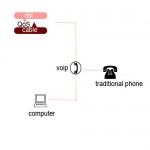Voice over Internet Protocol (VOIP) is one of the most prevalent topics today in the technology industry. As we grow more reliant on internet and its communication channels, the attraction to an internet based phone system cannot be undervalued. Since most of the markets and corporations understand a users demand for a cost effective yet feature rich phone system, there are many companies who provide, resell these features.
In Wikipedia, they state that VoIP are IP telephony, Internet telephony, voice over broadband (VoBB), broadband telephony, and broadband phone
This is true, because VOIP does not limit to phone system even though they are commonly associated with it.
When choosing a VOIP service company, very often there are 2 choices: on premise solution or a cloud solution. On premise solution refers to when a VoIP system is implemented in the customers own premises and sometimes maintained by the company who sells it or by the customer itself.
Cloud based solution is implemented in the sellers network infrastructure and maintained by the seller itself.
Very often the cloud based solution attracts customers because of the complexity of building and maintaining a server and making sure its running 24×7. With IT teams shirking in each company, this will be the best solution for most IT’s.
The second step is, are you current internet provider providing the good service, that is when a potential client calls your business and the call is very static or echo(y) then consider this is a lost customer. Therefore having a good internet speed is most important. Most VoIP providers give a QoS – Quality of Service. What this does is that based on the internet speed and internet traffic of the customer, they can prioritize the voice clarity in the customers network. For example if there is a lot of traffic in your company network due to back up running or application upgrade etc. then the QoS kicks and provides path to the VoIP data transfer so that voice quality and clarity is not impacted by the traffic. Its like a fire truck running through a congested high with all the bells and whistles.
The third part to a VoIP is do you have redundant network in place. This is usually put in business where missing a call can bring a lot of negative impact. This also means that you need a reliable secondary internet connection in place which will take the place if your primary internet connection fails. A good way to choose a secondary connection is to pick one that is not following the same connectivity as the primary one. This means that if you are using DSL connection as the primary one, then choose cable internet as the secondary one and vice versa.
The fourth and last step is that develop a backup plan when the internet connection or power outage happens. Let’s split this topic into two. First when the internet fails i.e. your primary and secondary connection fails but your power is still work. This can happen a lot of times in busy traffic areas. One solution is to have a backup traditional line setup in location so that that phone is still usable to meet your critical business needs. The second one is the backup plan when the power outage occurs. During this occurrence, the plan will be to redirect the call to a mobile phone or to an off premise phone.



